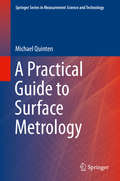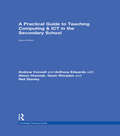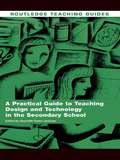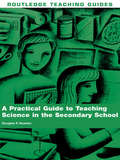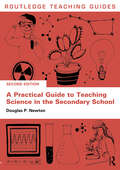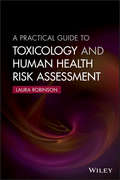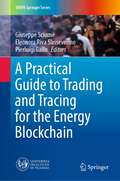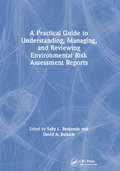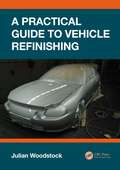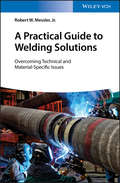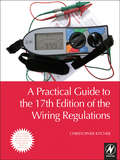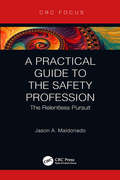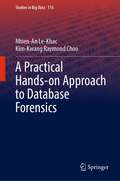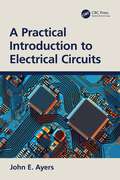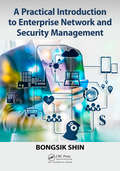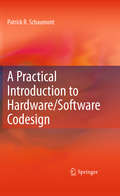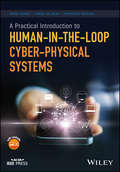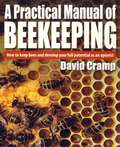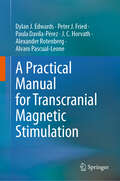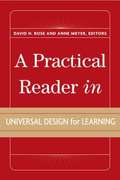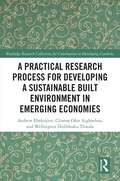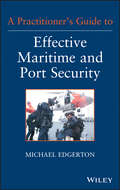- Table View
- List View
A Practical Guide to Surface Metrology (Springer Series in Measurement Science and Technology)
by Michael QuintenThis book offers a genuinely practical introduction to the most commonly encountered optical and non-optical systems used for the metrology and characterization of surfaces, including guidance on best practice, calibration, advantages and disadvantages, and interpretation of results. It enables the user to select the best approach in a given context. Most methods in surface metrology are based upon the interaction of light or electromagnetic radiation (UV, NIR, IR), and different optical effects are utilized to get a certain optical response from the surface; some of them record only the intensity reflected or scattered by the surface, others use interference of EM waves to obtain a characteristic response from the surface. The book covers techniques ranging from microscopy (including confocal, SNOM and digital holographic microscopy) through interferometry (including white light, multi-wavelength, grazing incidence and shearing) to spectral reflectometry and ellipsometry. The non-optical methods comprise tactile methods (stylus tip, AFM) as well as capacitive and inductive methods (capacitive sensors, eddy current sensors).The book provides: Overview of the working principlesDescription of advantages and disadvantagesCurrently achievable numbers for resolutions, repeatability, and reproducibilityExamples of real-world applications A final chapter discusses examples where the combination of different surface metrology techniques in a multi-sensor system can reasonably contribute to a better understanding of surface properties as well as a faster characterization of surfaces in industrial applications. The book is aimed at scientists and engineers who use such methods for the measurement and characterization ofsurfaces across a wide range of fields and industries, including electronics, energy, automotive and medical engineering.
A Practical Guide to Teaching Computing and ICT in the Secondary School (Routledge Teaching Guides)
by Andrew Connell Neil Stanley Anthony Edwards Alison Hramiak Gavin RhoadesA Practical Guide to Teaching Computing and ICT in the Secondary School offers straightforward guidance and inspiration to support all trainee and newly qualified teachers, as well as their tutors and mentors. It will also be a source of support and ideas for qualified teachers who wish to develop their teaching of Computing as a subject, in light of recent changes to the National Curriculum. Grounded in the best research and practice available, it focuses on the key pedagogical issues which arise during teacher training and offers stimulating activities based on tried and tested strategies. Comprehensively updated and restructured to reflect recent changes in the curriculum, Initial Teacher Training Standards and classroom technologies, it covers key aspects of Computing and ICT teaching: Planning pupil learning and progression Managing the learning environment Using assessment to improve pupil learning and your own teaching Developing pupils’ understanding of key concepts and ideas in Computing, including Computational Thinking and Programming Pupils’ common misconceptions and how to avoid them Helping pupils appreciate good and bad effects of computing. A Practical Guide to Teaching Computing and ICT in the Secondary School, written by experts in the field, provides detailed examples of theory in practice, enabling you to analyse and reflect on your own teaching in order to ensure pupil learning is maximised.
A Practical Guide to Teaching Design and Technology in the Secondary School
by Gwyneth Owen-JacksonContaining a wealth of practical activities and materials that provide excellent opportunities to analyse learning and performance within Design and Technology, this book also includes case studies and examples of existing good practice and a range of tried-and-tested strategies. Specially designed to be written in directly it provides a useful record of progress and is accompanied by a Companion Website. Designed to be used by student teachers, NQTs and beginning teachers, this workbook covers each main specialist area of Design Technology: electronics and communications technology (ECT), food technology, materials technology and textiles technology. Topics covered include: design and technology in the school curriculum the importance of health and safety the use of ICT in the teaching of design and technology planning lessons managing the classroom assessment issues the integration of literacy, numeracy, citizenship and sustainability into design and technology your own professional development. This book complements the market-leading textbook Learning to Teach Design and Technology in the Secondary School (also published by Routledge), but can also be used equally successfully on its own.
A Practical Guide to Teaching Science in the Secondary School (Routledge Teaching Guides)
by Douglas P. NewtonThis practical and accessible workbook is designed to support student teachers as they develop their basic teaching skills and increase their broader knowledge and understanding for teaching science. Newly qualified and beginning teachers should also find it useful. It contains all the advice, guidance and resources new and student science teachers need to reflect on and develop their teaching practice, helping them to plan lessons across the subject in a variety of teaching situations. Helpful features include: case studies examples of pupils’ work examples of existing good practice a range of tried-and-tested teaching strategies photocopiable resources and training materials activities in each chapter to help student history teachers analyse their learning and performance web links for further reading on evidence-based practice.
A Practical Guide to Teaching Science in the Secondary School (Routledge Teaching Guides)
by Douglas P. NewtonA Practical Guide to Teaching Science in the Secondary School is designed to support student teachers as they develop their teaching skills and increase their broader knowledge and understanding for teaching science. It offers straightforward advice and inspiration on key topics such as planning, assessment, practical work, the science classroom, and on to the broader aspects of teaching science. This thoroughly updated second edition reflects on new expectations, requirements, and practices in science teaching, with chapters exploring key and contemporary topics such as: The nature of science and scientific argument The various kinds of thinking emphasised in science and how to exercise them How to engage students in learning Assessment for and of learning Diverse needs and how to meet them The use of technology to support teaching and learning Learning at a distance. Designed to be used independently or alongside the popular textbook Learning to Teach Science in the Secondary School, this book is packed with revised and updated case studies, examples of pupils' work, and resources and activities in every chapter. It provides everything trainee and early career teachers need to reflect on and develop their teaching practice, helping them to plan lessons across the subject in a variety of teaching situations.
A Practical Guide to Toxicology and Human Health Risk Assessment
by Laura RobinsonToxicology – the study of the adverse effects of chemicals on living organisms is the cornerstone to all aspects of chemical safety and knowledge of the subject is needed in a wide spectrum of fields from the chemical industry to medicine, emergency services, forensics, and regulatory science. Toxicology involves the study of symptoms, mechanisms, treatments and detection of poisoning ... especially the poisoning of people.The many problems arising from a poor understanding of toxicology and its applications in hazard communication and chemical safety motivated the author’s training courses and webinars, leading to this valuable book.Providing a practical and accessible guide, A Practical Guide to Toxicology and Human Health Risk Assessment enables readers to quickly build up knowledge and understanding of toxicology and its use in hazard identification, which is a fundamental part of chemical risk assessment. The book also covers current toxicological testing strategies and the use of physicochemical test data in hazard identification and exposure assessment.Examples are provided throughout the book to highlight important issues along with a summary of the key points that have been covered in each of the respective chapters. The book concludes with a listing of online resources on toxicology and risk assessment.
A Practical Guide to Trading and Tracing for the Energy Blockchain (UNIPA Springer Series)
by Eleonora Riva Sanseverino Giuseppe Sciumè Pierluigi GalloThis book discusses the main features, fundamental principles, and application areas of blockchain technology. It explains how this technology can contribute to the electricity market by enabling the implementation of new business models and new energy scenarios.The first chapter is an introductory section which covers the basic elements for framing the blockchain in the different application fields. The following chapters describe the various phases of the Italian electricity market and the players involved in each phase, the new business models and the main regulations; the features of blockchain that are useful for the energy system; and the integration of a blockchain platform for the execution of Demand Response events in an existing power grid. In the fifth chapter the results of the experimental implementation of the architecture described previously are presented, and in the final chapter the BloRin project is presented, which aims to create a blockchain-based platform for renewable energy deployment and energy exchange management. The volume targets graduate students, researchers and practitioners, and addresses the development of a new methodology for the implementation of energy services using blockchain technology, providing a guide in the blockchain area for the energy sector.
A Practical Guide to Understanding, Managing, and Reviewing Environmental Risk Assessment Reports
by Sally L. Benjamin David A. BelluckA Practical Guide to Understanding, Managing and Reviewing Environmental Risk Assessment Reports provides team leaders and team members with a strategy for developing the elements of risk assessment into a readable and beneficial report. The authors believe that successful management of the risk assessment team is a key factor is quality repor
A Practical Guide to Vehicle Refinishing
by Julian WoodstockA guide to refinishing suitable for complete beginners and more advanced technicians. This heavily illustrated guide will help students through their Level 2 and 3 vehicle refinishing qualifications and be useful as a reference and trouble shooter for more advanced technicians. It is set out in the order in which a vehicle is repaired. There are sections covering: identifying different substrates, with an explanation of how this affects the materials to be chosen and techniques to be used preparation work required prior to the application of foundation materials how to choose the correct foundation material shaping and sanding techniques different types of popular top coats and the required application techniques glossaries for tools and equipment health and safety considerations This book has been designed and written by a true ‘petrol head’ whose career and hobbies have revolved around motor vehicles and the refinishing trade. He has been in the motor trade for more than 16 years and has delivered Refinishing qualifications to students for over 11 years. Someone who has never before held a spray gun should be able to understand stage-by-stage, or they can dip in for precise trouble shooting and tips.
A Practical Guide to Welding Solutions: Overcoming Technical and Material-Specific Issues
by Robert W. Messler Jr.The book approaches the problems encountered during welding and in the welds produced starting with the problems and working backward to the causes and resolutions. The book is logically divided into three parts to help the readers and cognizant engineers hunt down the cause and cure for an encountered problem. The first part shows how certain problems manifest themselves, the second part goes into detail where these problems occur, and the third part elucidates their causes. Every chapter ends with a table for trouble-shooting problems addressed in that chapter.
A Practical Guide to the 17th Edition of the Wiring Regulations
by Christopher KitcherThis book covers all the basics of inspection and testing and clearly explains all the legal requirements. It not only tells you what tests are needed but also describes all of them step-by-step with the help of colour photos. Sample forms show how to verify recorded test results and how to certify and fill in the required documentation. The book is also packed with handy advice on how to avoid and solve common problems encountered on the job.With its focus on the practical side of the actual inspection and testing rather than just the requirements of the regulations, this book is ideal for students, experienced electricians and those working in allied industries, such as plumbers and heating specialists, kitchen and bathroom fitters, alarm installers and others, whether they are working on domestic or industrial installations.All the theory required for passing the City & Guilds Level 3 Certificate in Inspection, Testing and Certification of Electrical Installations (2391-01) is covered. The book also includes sample questions and scenarios as encountered in the exams. Questions encourage readers to research answers in the On-Site Guide, as required in the exams for Part P Competent Person courses from EAL, NICEIC, NAPIT, BPEC and others. Model answers are provided for all questions. The book will also help prepare students on City & Guilds 2330 Level 3 courses, NVQs and apprenticeship programmes for their practical inspection and testing exams.Chris Kitcher is an Electrical Installation lecturer at Central Sussex College and has 45 years of experience in the electrical industry.
A Practical Guide to the Manufacture of Sulfuric Acid, Oleums, and Sulfonating Agents
by Navin G. Ashar Kiran R. GolwalkarThis critical volume provides practical insights on sulfuric acid and related plant design and on techniques to improve and enhance substantially the efficiency of an existing plant by means of small modifications. The book provides readers with a better understanding of the state-of-art in sulfuric acid manufacture as well as, importantly, in the manufacture of value-added products based on sulfur that are also associated with the manufacture of sulfuric acid. Overall, engineers and plant managers will be introduced to technologies for making their sulfuric acid enterprises more productive, remunerative, and environmentally friendly. A Practical Guide to the Manufacture of Sulfuric Acid, Oleums, and Sulfonating Agents covers sulfuric acid and derivative chemical plant details from the nuts-and-bolts level to a holistic perspective based on actual field experience. The book is indispensable to anyone involved in implementing a sulfuric acid or related chemical plant.
A Practical Guide to the Safety Profession: The Relentless Pursuit
by Jason A. MaldonadoA Practical Guide to the Safety Profession: The Relentless Pursuit will help reshape the way we talk about safety, prompt action, and engage workers from all levels of an organization. The book includes real-life experiences and characters that are relatable to anyone who has worked in the safety and health field for any amount of time. It will provide answers for every safety professional who has ever asked: "Is this actually making people safer?" It shines a light on ineffective practices that drive a wedge between the safety professional and the people they support and then provides meaningful alternative practices. Features: Provides a streamlined process for eliminating high impact hazards, Emphasizes concepts that are immediately actionable with little to no investment costs, and Includes real-life studies and examples.
A Practical Hands-on Approach to Database Forensics (Studies in Big Data #116)
by Nhien-An Le-Khac Kim-Kwang Raymond ChooAdopting an experimental learning approach, this book describes a practical forensic process to acquire and analyze databases from a given device and/or application. Databases hold important, sensitive, and/or confidential information and are a crucial source of evidence in any digital investigation. This also reinforces the importance of keeping up to date on the cyber-threat landscape as well as any associated database forensic challenges and approaches. The book also guides cyber-forensic researchers, educators, and practitioners through the process of conducting database forensics and investigations on mobile devices, Internet of Things (IoT) devices, web browsers, and end-to-end encrypted instant messaging applications. Given the fast-changing database forensics landscape, this book will be of interest to researchers, educators, and practitioners in the field, as well as students who want to learn about the database investigation.
A Practical Introduction to Electrical Circuits
by John E. AyersA Practical Introduction to Electrical Circuits represents a fresh approach to the subject which is compact and easy to use, yet offers a comprehensive description of the fundamentals, including Kirchhoff’s laws, nodal and mesh analysis, Thevenin and Norton’s theorems, and maximum power transfer for both DC and AC circuits, as well as transient analysis of first- and second-order circuits. Advanced topics such as mutual inductance and transformers, operational amplifier circuits, sequential switching, and three-phase systems reinforce the fundamentals. Approximately one hundred solved examples are included within the printed copy. Extra features online include over two hundred additional problems with detailed, step-by-step solutions, and 40 self-service quizzes with solutions and feedback.
A Practical Introduction to Enterprise Network and Security Management
by Bongsik ShinComputer networking and cybersecurity are challenging subjects, partly because of the constant rise and fall of related technologies and IT paradigms. As the title implies, much focus of this book is on providing the audience with practical, as well as, theoretical knowledge necessary to build a solid ground for a successful professional career. A Practical Introduction to Enterprise Network and Security Management contains 12 chapters of the correct amount of coverage for a semester or quarter. It balances introductory and fairly advanced subjects on computer networking and cybersecurity to deliver effectively technical and managerial knowledge. It explains sometimes challenging concepts in a manner that students can follow with careful reading. A Practical Introduction to Enterprise Network and Security Management is designed to offer impactful, hands-on learning experiences without relying on a computer lab. First, each chapter comes with practical exercise questions. In the class setting, they are good as individual or group assignments. Many of them are based on simulated or real cases, and take advantage of actual industry products and systems for a reader to better relate theories to practice. Second, there are a number of information-rich screen shots, figures, and tables in each chapter carefully constructed to solidify concepts and thus enhance visual learning. A Practical Introduction to Enterprise Network and Security Management Is written for students studying management information systems, accounting information systems, or computer science in a semester of 15 to 16 weeks, and exposed to the subject for the first time Takes advantage of many real cases and examples, and actual industry products and services (software, hardware, and configurations) so that students can better relate concepts and theories to practice Explains subjects in a systematic, but very practical manner that students can follow through Provides students with practical understanding of both computer networking and cybersecurity Contains highly practical exercise questions, which can be individual or group assignments within or without the class, included in each chapter to reinforce learning. In addition to the thorough technical details, managerial issues including, enterprise network planning, design, and management from the practitioner’s perspective are embedded throughout the text to assist balanced learning. Bearing in mind of the critical importance of security in today’s enterprise networks, the text discusses the implications of network design and management on enterprise security whenever appropriate. Lastly, to reinforce knowledge in security management further, two chapters introduce the fundamentals of cybersecurity in terms of threat types and defense techniques.
A Practical Introduction to Hardware/Software Codesign
by Patrick R. SchaumontThis book provides a systematic introduction to the topic of Hardware-Software Codesign. The material emphasizes the basic ideas, and the practical aspects of Hardware-Software Codesign. The book developed from a course on the topic of Hardware-Software Codesign, organized by the author at Virginia Tech. It is separated into four differenct sections; Basic Concepts, Custom Architectures, Hardware/Software Interfaces, and Applications. The author covers many concepts including the various forms of expressing computations, sequential and parallel implementations, control-flow and data-flow, control dependency and data dependency, latency and throughput as well as the architecture design space of hardware data paths, finite state machines, micro-programmed machines, instruction-set processors, system-on-chip, and on-chip buses. The material also includes the different forms of hardware/software interfaces, their impact on performance, hardware cost, and software complexity. The book contains information on hardware/software integration of components on top of hardware/software interfaces as well as design methodology and design flows for hardware-software codesign including performance evaluation, verification and synthesis of hardware and software implementations. Problems are included at the end of each chapter and a solutions manual will be available for instructors.
A Practical Introduction to Human-in-the-Loop Cyber-Physical Systems
by David Nunes Jorge Sá Silva Fernando BoavidaThe first book focusing on one of the hottest new topics in Internet of Things systems research and development Studies estimate that by 2020 we will have a vast Internet of Things (IoT) network comprising 26 billion connected devices, including everything from light bulbs to refrigerators, coffee makers to cars. From the beginning, the concept of cyber-physical systems (CPS), or the sensing and control of physical phenomena through networks of devices that work together to achieve common goals, has been implicit in the IoT enterprise. This book focuses on the increasingly hot topic of Human-in-the-loop Cyber-Physical Systems (HiTLCPS)—CPSs that incorporate human responses in IoT equation. Why have we not yet integrated the human component into CPSs? What are the major challenges to achieving HiTLCPS? How can we take advantage of ubiquitous sensing platforms, such as smartphones and personal devices to achieve that goal? While mature HiTLCPS designs have yet to be achieved, or a general consensus reached on underlying HiTLCPS requirements, principles, and theory, researchers and developers worldwide are on the cusp of realizing them. With contributions from researchers at the cutting edge of HiTLCPS R&D, this book addresses many of these questions from the theoretical and practical points of view. An essential primer on a rapidly emerging Internet-of-Things concept, focusing on human-centric applications Discusses new topics which, until now, have only been available in research papers scattered throughout the world literature Addressed fundamental concepts in depth while providing practical insights into the development of complete HiTLCPS systems Includes a companion website containing full source-code for all of the applications described This book is an indispensable resource for researchers and app developers eager to explore HiTL concepts and include them into their designs. It is also an excellent primer for advanced undergraduates and graduate students studying IoT, CPS, and HiTLCPS.
A Practical Introduction to Supply Chain
by David PheaseyIn many businesses, supply chain people are trapped in reactive roles where they source, contract, purchase, receive, warehouse, and ship as a service. However, in some businesses suppliers contribute to improvement programs, technology, funding, marketing, logistics, and engineering expertise. Breaking into a proactive supply chain role takes broad thinking, a talent for persuasion, and the courage to go after it. This book supplies proven methods to help you do so.A Practical Introduction to Supply Chain describes how to run an efficient supply chain that exceeds expectations in terms of cost, quality, and supplier delivery. It explains the need to integrate systems, the flow of information, and the way in which people work together between commercial purchasing, materials management, and distribution parts of the supply chain.Sharing powerful insights from the perspective of a supply chain manager, the book details practical techniques drawn from the author’s decades of experience. It presents methods that apply directly to supply chains involving a physical product, manufactured internally or outsourced, as well as physical operations such as oilfield services.This book demonstrates how to make a supply chain organization work in practice—contributing more to business success than traditional purchasing and logistics organizations can. In addition to writing about practical supply chain issues and approaches, the author also describes proven methods he used while working with client teams on assignments. He also details some of the ways his teams used to manage the people part of the change.
A Practical Manual Of Beekeeping: How to Keep Bees and Develop Your Full Potential as an Apiarist
by David CrampA fascinating hobby; a remunerative business; or a globetrotting career? Which type of beekeeper do you want to be? It is entirely up to you: beekeeping can provide it all.Beekeeping can provide anyone with an interesting and useful hobby or a lucrative and rewarding business. It is recognised as a vital agricultural industry and can therefore also offer you a globe trotting career. The whole subject is, however, often shrouded in mystery and loaded with jargon, leaving many people unaware of its true potential or how to start. This book strips away all the mystery and explains step by step how - from day one - you can start beekeeping as a hobby; how you can progress to running a beekeeping business; or how you can start a career as a beekeeper which can quite easily take you all over the world. No other guide explains in such detail the true potential and accessibility of beekeeping or of being a beekeeper.
A Practical Manual Of Beekeeping: How to Keep Bees and Develop Your Full Potential as an Apiarist
by David CrampA fascinating hobby; a remunerative business; or a globetrotting career? Which type of beekeeper do you want to be? It is entirely up to you: beekeeping can provide it all.Beekeeping can provide anyone with an interesting and useful hobby or a lucrative and rewarding business. It is recognised as a vital agricultural industry and can therefore also offer you a globe trotting career. The whole subject is, however, often shrouded in mystery and loaded with jargon, leaving many people unaware of its true potential or how to start. This book strips away all the mystery and explains step by step how - from day one - you can start beekeeping as a hobby; how you can progress to running a beekeeping business; or how you can start a career as a beekeeper which can quite easily take you all over the world. No other guide explains in such detail the true potential and accessibility of beekeeping or of being a beekeeper.
A Practical Manual for Transcranial Magnetic Stimulation
by Alvaro Pascual-Leone Alexander Rotenberg Dylan J. Edwards Peter J. Fried Paula Davila-Pérez Jared C. HorvathThis practical guide to transcranial magnetic stimulation (TMS) offers step-by-step instruction for the most commonly used TMS protocols in humans. TMS equipment is increasingly available in University and Hospital settings and even small clinics. TMS protocols are often taken from disparate publications, and there has not been a single comprehensive and practical reference for the most common procedures. The current book contains structured steps for the various TMS protocols in addition to relevant fundamental information, including a practical summary of principles of TMS and a glossary of terms. This book is designed to be a quick reference on the office or clinic desk, or in the laboratory, and would be as useful for guiding research and clinical laboratory activities as it would for deciphering TMS study methodologies in the literature.
A Practical Reader in Universal Design for Learning
by Anne Meyer David H. RoseUniversal Design for Learning (UDL) stands at the forefront of contemporary efforts to create universal access to educational curricula for all students, including those with disabilities. The universal in UDL does not mean there is a single optimal solution for everyone.
A Practical Research Process for Developing a Sustainable Built Environment in Emerging Economies (Routledge Research Collections for Construction in Developing Countries)
by Andrew Ebekozien Clinton Ohis Aigbavboa Wellington Didibhuku ThwalaA Practical Research Process for Developing a Sustainable Built Environment in Emerging Economies aims to fill the dearth of practical research guidance and reference material with specific focus on the built environment in developing countries. Global policy agendas such as Agenda 2030 (the SDGs) highlight the importance and growth of research and knowledge from emerging nations who are increasingly contributing to research that is critical for development and advancement. The role of built environment practitioners will continue to evolve by building on the sound foundations laid down by the professions and by exploiting to the full the new technologies available to us through conducting innovative research, but more guidance on the research process is necessary to ensure the integrity and quality of the output.This book has been structured so that each chapter is largely free-standing, allowing the reader (undergraduate, postgraduate, or practitioner) to reference the material with ease. It aims to provide practical guidance on conducting research and on writing a dissertation or report and begins by considering the general research background in a built environment context. It then covers research ethics, before moving on to discuss the importance of selecting the right research topic and title and writing a clear abstract. The chapters then cover introducing a research project, and the authors include a section on the problem statement, research questions, aims and objectives, research gap(s), and motivations for the study. The book goes on to cover the literature review section, theoretical and conceptual frameworks, the various types of methodological approaches, and when to apply them. The findings section, discussion of the results, and the study’s implications are then discussed, before the final chapters cover the conclusion and recommendations.The book provides a useful reference for higher education students, graduates, postgraduates, and practitioners engaged in all aspects of construction and built environment research.
A Practitioner's Guide to Effective Maritime and Port Security
by Michael EdgertonSets forth practices to ensure security and foster international tradeWritten with an international perspective, this book analyzes the complex set of factors affecting the security of port and maritime operations, including shipping, politics, economics, crime, and terrorism. Author Michael Edgerton critiques current approaches to maritime and port security based on his more than twenty-five years of experience in the field. He not only points out vulnerabilities in today's practices, but also provides a set of proven and tested recommendations that recognize the role and interests of both government and the private sector in enhancing security while ensuring the flow of international trade. Readers may be surprised to learn that, with greater efficiency, they can actually improve security while reducing the cost of security at the same time.Using real-world case studies to support its analyses and recommendations, A Practitioner's Guide to Effective Maritime and Port Security:Reviews the core components of the international maritime operating environmentAssesses the potential threats to ports in the maritime environmentExamines approaches to maritime port security in the United States, European Union, and around the worldPresents principles for effective, risk-based maritime and port securityAt the end of the book, two appendices provide a framework for conducting security risk assessments and threat assessments. There's also a third appendix to help organizations assess their "risk appetite."Recommended for students and professionals responsible for the safety and security of ports and maritime trade, this book reframes port and maritime security as a key component of a multidisciplinary system in which secure and efficient trade is the objective.
